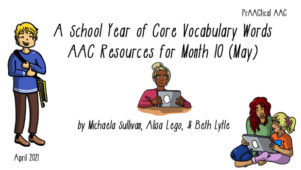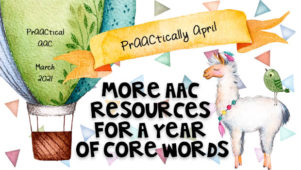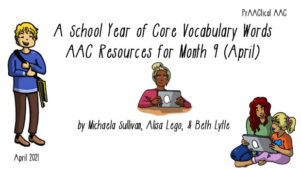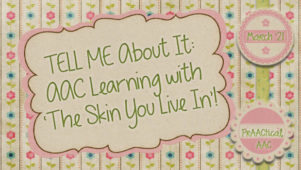Throwback Thursday: Teaching Core Vocabulary
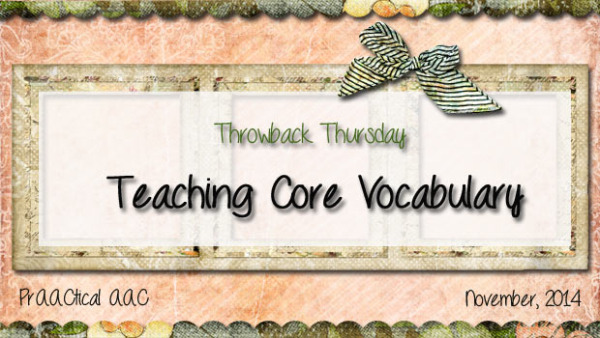
While I’m soaking up AAC knowledge at the ASHA Convention, here’s a post from the past.
::::::::::::::::::::::::::::::::::::::::::::::::::::::::
Among the many changes that the AAC field has experienced in the last decade is the notion that core vocabulary is (or should be) an integral part of any AAC system. We grew to understand the limitations of AAC supports that consist primarily of nouns and descriptors, realizing that those kinds of communication displays restricted our clients to requesting and labeling. Our field realized the inadequacy of providing only prestored messages (e.g., limited the client’s ability to communicate anything novel, not flexible enough to meet most communication needs, etc.). In essence, we realized that without core vocabulary, we were imposing a ceiling on language development.
We’re thrilled to see so many communication boards, books, SGDs, and AAC apps reflect this knowledge. Having tools with the appropriate vocabulary is a big step in the right direction. But to really shatter the ceiling of language development, we have to be good at teaching the use of core language. Teaching words like ‘it,’ ‘do,’ and ‘not’ is a lot different than teaching words like ‘cookie’ and ‘bubbles.’ It’s no wonder that SLPs struggle with this: It’s not easy to teach abstract concepts and most core words are a lot more abstract than the nouns, verbs, and descriptors we focused on 10+ years ago.
This month, we’re focusing on ways to teach core language. We’ll start off with some basic principles and the move into applying teaching strategies to lists of core words.
In November, we introduced the framework we use for semantic intervention in AAC that included:
- Introducing the new word(s) using focused AIDED language stimulation;
- Teaching the new word(s) with explicit instruction activities;
- Elaborating on the new word meanings with engaging practice activities;
- Providing repeated exposure to the new word(s) on an ongoing basis; and,
- Checking for understanding and reteaching, as necessary.
That same approach works here, but there are some special considerations in implementation. Activities for explicit instruction of words like ‘have,’ ‘some’ and ‘you’ are a bit different than activities for teaching words like ‘music’ and ‘Play Doh.’
Here are some thoughts to get us started.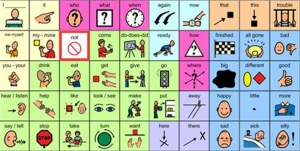
-
Provide access to core vocabulary: Before we can start teaching core vocabulary, we have to give our clients with AAC needs communication tools that have a good base of core vocabulary. That can be done in a no tech way, using communication boards and books. Low tech AAC devices can also be set up for core language. And, of course, some high tech SGDs and AAC apps do that as well.
-
Don’t underestimate the amount of vocabulary needed: It’s tempting to size up beginning communicators who are expressing very little and draw the conclusion that they only need a few dozen words on their AAC devices/tools. If we take that approach, though, we’re limiting their exposure to a wider vocabulary set. Finding the balance between too few and too many takes some clinical judgment-there are no hard and fast rules.
— We approach this pretty much the way we do with speaking children. We model language slightly above their current abilities, right? So with our AAC learners, we provide AAC tools that allow us to do the same thing. If he knows or uses about a dozen words, then I might start with AAC tools that have about 18-24 words. That gives me room to use it to talk to him and provide receptive exposure to words that he doesn’t yet know. Some of them are the next words that we’re planning to teach. Think of it as a ladder. If you don’t provide access to the next rung, he won’t be able to climb. If I only provide access to the words he knows now, how will he ever learn new words?
ladder. If you don’t provide access to the next rung, he won’t be able to climb. If I only provide access to the words he knows now, how will he ever learn new words?
-
Keep the process moving: As the learner starts to catch on to the words you are teaching, add more so you can begin to expose them to new vocabulary. It’s a fluid process.
-
Provide frequent opportunities for core word practice: By definition, core words are common and appropriate for almost every situation. One of the best ways to get learners competent with core vocabulary is to have them say those words frequently. If Jenna’s target words are ‘it,’ ‘do,’ and ‘not,’ then she should be saying them all day long. These words, individually and in short sentences, can be fit into almost any daily routine or activity (e.g. Do it. I do. Do not. You do not). Once they get used to the idea that you will build these opportunities into their routine, pause expectantly, and help them say the words, it will become a normal part of their everyday
-
Expect to provide a lot of support: In the beginning stages of word learning, it’s normal for AAC learners to need help. At this stage, it’s better to give them practice saying the word correctly with some help, than having them fumble around on their own and not say it at all.
-
It’s not about mastery: Try not to get trapped into thinking that AAC learners have to prove that they know their current words before we give them access to more. Instead, look for signs that they are starting to ‘get it.’ We do more harm by restricting access to vocabulary than we do by giving them too many words. Unless you have strong data to show that a particular communicator learns fastest when they achieve mastery before moving on, give them the benefit of the doubt. It’s almost 30 years since Anne Donellan planted this seed. In her 1984 article, she suggested that when we don’t have enough information to be sure, we should operate on the assumption that, if wrong, leads to the least dangerous effect on the outcome.
Teaching core language, the basic set of words we all use to get through our daily lives, can take more thought and planning but the payoffs are huge. Do you have tips for teaching this type of vocabulary? We’d love to hear them!
Donnellan, A. (1984). The criterion of the least dangerous assumption. Behavior Disorders, 9, 2, 141-150.
Filed under: PrAACtical Thinking
Tagged With: core language, core vocabulary
This post was written by Carole Zangari

